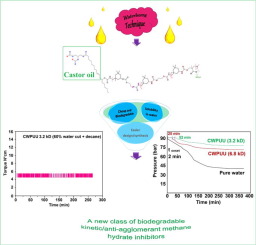当前位置:
X-MOL 学术
›
Chem. Eng. Sci.
›
论文详情
Our official English website, www.x-mol.net, welcomes your
feedback! (Note: you will need to create a separate account there.)
A new class of promising biodegradable kinetic/anti-agglomerant methane hydrate inhibitors based on castor oil
Chemical Engineering Science ( IF 4.1 ) Pub Date : 2019-10-01 , DOI: 10.1016/j.ces.2019.05.055 Abdolreza Farhadian , Mikhail A. Varfolomeev , Arman Kudbanov , Svetlana R. Gallyamova
Chemical Engineering Science ( IF 4.1 ) Pub Date : 2019-10-01 , DOI: 10.1016/j.ces.2019.05.055 Abdolreza Farhadian , Mikhail A. Varfolomeev , Arman Kudbanov , Svetlana R. Gallyamova

|
Abstract This study is devoted to the evaluation of vegetable oils (in this case castor oil) as an inexpensive, sustainable, environment-friendly, natural and promising resource to design/synthesis efficient kinetic/anti-agglomerant methane hydrate inhibitors. The castor-based waterborne polyurea/urethanes (CWPUUs) were synthesized on the basis of the waterborne technique. The high-pressure autoclave cell and high-pressure micro-differential scanning calorimeter (HP-μDSC) using methane gas were applied to evaluate the inhibition performance of CWPUUs as an inhibitor for methane gas hydrate formation. The results of gas uptake tests confirm that the CWPUUs show high efficiency as kinetic hydrate inhibitors (KHIs). The CWPUUs with ∼3.2 and 6.8 kD molecular weight delayed the onset time of methane hydrate formation by a factor of 26.8 and 13 times and reduced the methane hydrate growth rate by a factor of 3.8 and 2.5 times in comparison with pure water. The results were further confirmed through DSC measurements, in which the usage of CWPUUs with ∼3.2 and 6.8 kD molecular weight decreased the mean onset temperature of methane hydrate formation on 6.1 and 4.7 °C compared to pure water, respectively. Additives of CWPUUs (1 wt % solution) increased the mean onset time of methane hydrate formation from 2.3 h for pure water to 8.7 and 6.4 h. CWPUUs also demonstrated the thermodynamic inhibition by decreasing the melting temperature of methane hydrates comparing to the pure water system. On the other hand, the torque measurements were used to assess anti-agglomerant performance of CWPUUs. During the methane hydrate formation in the presence of CWPUUs, the torque changes remained constant that suggests the hydrate particles stayed separate without aggregation. Moreover, synthesized CWPUUs can be related to biodegradable substances because their BOD5/CODcr value measured in this work is equal to 0.389. Hence, the application of CWPPUs can be a prospective option for delaying the onset time/temperature of hydrate formation, reducing hydrate growth rate and preventing agglomeration of hydrate particles, and this strategy refers to the terms of green chemistry.
中文翻译:

一类有前景的基于蓖麻油的可生物降解动力学/抗凝聚甲烷水合物抑制剂
摘要 本研究致力于评估植物油(在这种情况下为蓖麻油)作为一种廉价、可持续、环境友好、天然和有前途的资源,用于设计/合成有效的动力学/抗凝聚剂甲烷水合物抑制剂。蓖麻基水性聚脲/聚氨酯(CWPUUs)是在水性技术的基础上合成的。应用高压釜室和使用甲烷气体的高压微差示扫描量热仪 (HP-μDSC) 来评估 CWPUUs 作为甲烷气体水合物形成抑制剂的抑制性能。气体吸收测试的结果证实,CWPUU 作为动力学水合物抑制剂 (KHI) 显示出高效率。分子量约为 3.2 和 6.8 kD 的 CWPUU 将甲烷水合物形成的开始时间延迟了 26 倍。8 倍和 13 倍,与纯水相比,甲烷水合物的生长速度降低了 3.8 倍和 2.5 倍。通过 DSC 测量进一步证实了结果,其中与纯水相比,使用分子量约为 3.2 和 6.8 kD 的 CWPUU 使甲烷水合物形成的平均起始温度分别降低了 6.1 和 4.7 °C。CWPUU 的添加剂(1 wt% 溶液)将甲烷水合物形成的平均开始时间从纯水的 2.3 小时增加到 8.7 和 6.4 小时。与纯水系统相比,CWPUUs 还通过降低甲烷水合物的熔化温度来证明热力学抑制作用。另一方面,扭矩测量用于评估 CWPUU 的抗凝聚性能。在 CWPUU 存在下甲烷水合物形成过程中,扭矩变化保持不变,表明水合物颗粒保持分离而没有聚集。此外,合成的 CWPUU 可能与可生物降解物质有关,因为在这项工作中测量的 BOD5/CODcr 值等于 0.389。因此,CWPPUs 的应用可以成为延迟水合物形成的开始时间/温度、降低水合物生长速率和防止水合物颗粒团聚的前瞻性选择,这种策略是指绿色化学的术语。
更新日期:2019-10-01
中文翻译:

一类有前景的基于蓖麻油的可生物降解动力学/抗凝聚甲烷水合物抑制剂
摘要 本研究致力于评估植物油(在这种情况下为蓖麻油)作为一种廉价、可持续、环境友好、天然和有前途的资源,用于设计/合成有效的动力学/抗凝聚剂甲烷水合物抑制剂。蓖麻基水性聚脲/聚氨酯(CWPUUs)是在水性技术的基础上合成的。应用高压釜室和使用甲烷气体的高压微差示扫描量热仪 (HP-μDSC) 来评估 CWPUUs 作为甲烷气体水合物形成抑制剂的抑制性能。气体吸收测试的结果证实,CWPUU 作为动力学水合物抑制剂 (KHI) 显示出高效率。分子量约为 3.2 和 6.8 kD 的 CWPUU 将甲烷水合物形成的开始时间延迟了 26 倍。8 倍和 13 倍,与纯水相比,甲烷水合物的生长速度降低了 3.8 倍和 2.5 倍。通过 DSC 测量进一步证实了结果,其中与纯水相比,使用分子量约为 3.2 和 6.8 kD 的 CWPUU 使甲烷水合物形成的平均起始温度分别降低了 6.1 和 4.7 °C。CWPUU 的添加剂(1 wt% 溶液)将甲烷水合物形成的平均开始时间从纯水的 2.3 小时增加到 8.7 和 6.4 小时。与纯水系统相比,CWPUUs 还通过降低甲烷水合物的熔化温度来证明热力学抑制作用。另一方面,扭矩测量用于评估 CWPUU 的抗凝聚性能。在 CWPUU 存在下甲烷水合物形成过程中,扭矩变化保持不变,表明水合物颗粒保持分离而没有聚集。此外,合成的 CWPUU 可能与可生物降解物质有关,因为在这项工作中测量的 BOD5/CODcr 值等于 0.389。因此,CWPPUs 的应用可以成为延迟水合物形成的开始时间/温度、降低水合物生长速率和防止水合物颗粒团聚的前瞻性选择,这种策略是指绿色化学的术语。






























 京公网安备 11010802027423号
京公网安备 11010802027423号